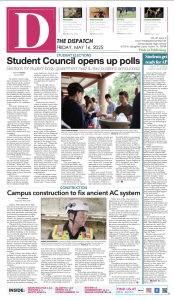Vaping conversations heat up
Sage Epstein, Isabella del Nido
CONVERSATIONS SPARK: Senior Andie Garza, Keira Folkers, and Isabella Grahmann wear orange t-shirts to school. On Oct. 20, 2021, Bowie students and staff wore orange to show support in efforts against vaping.
November 11, 2021
Student Leadership’s ‘No Vape October’ encouraged students to quit vaping
John Smith felt the urge.
He was sitting in his algebra class, listening to a boring lecture about inverse matrices and he felt the need to go to the E hall bathroom to hit his vape.
He knew this addiction was not something that was good for him, but he couldn’t control it. He couldn’t even think of the last time he had made it through the day without vaping.
Vaping had become a daily routine for him and he was unable to focus without it.
While John Smith isn’t a real student at Bowie, the story is one played out everyday in the hallways. Addiction is a problem across the country. In a recent report by the U.S. Health Public Service, between 2011 and 2015 e-cigarette use among high school students increased by over 900%.
The same report states that young people ages 15 to 17 are 16 times more likely to vape than people aged 25 to 34. With the rise of this increase and the effects of vaping, Bowie’s nurse Shari Petersen and Student Leadership have spent the past month implementing ‘No Vape October’ at Bowie.
“NoVapeOctober is an initiative that Nurse Petersen and my Student Leadership students are working on this year to help Bowie students become aware of a program that can help students quit vaping in a teenage friendly way,” Student Leadership teacher Vickie Benson said.
In 2019, a poll conducted by the Truth Initiative reflected the conclusion that two-thirds of people aged 15 to 21 don’t know that the product contained nicotine. Moreover, despite an outbreak in deaths or lung disease cases because of vaping, more than 20% of 18- to 38-year-olds called vaping harmless and nonaddictive.
“A lot of people think it’s a safer alternative than smoking, and it’s not,” Petersen said. “In fact, it actually has the potential to make you more addicted and more dependent than actual cigarettes, because the amount of nicotine you can get in a vape is way higher than you actually get from smoking a cigarette.
A recent study by the Centers for Disease Control and Prevention (CDC) found that 99% of the e-cigarettes sold in the United States contained nicotine. The article also conveyed the idea that various e-cigarette labels don’t disclose that they contain nicotine or mark it as having 0% nicotine, but actually contain this toxic chemical.
“Through NoVapeOctober, I learned the facts about the various negative consequences that occur through vaping,” senior Camilla Cooper said. “I hope that Bowie students were able to educate themselves on the harmful effects of these e-cigarettes and have taken some form of help from the program.”
Last year during the pandemic, Petersen took a course where she researched information on vaping and its side effects. She found a program called ‘This is Quitting’ that assist students in understanding the risks that are associated with vaping, especially risks that are overlooked.
“The program is 100% private and anonymous, and it’s free,” Petersen said. “Essentially, a student types in 88709 to their phone, and to that they text the keyword ‘NoVapeBowie’ and that starts them down the road to quitting. Once they text that it’ll give them prompts to respond to such as tips to quit, helpful age-appropriate information, and responses to ‘SOS texts’.”
The ‘Truth Initiative’ organization, utilized by Bowie, has been directly responsible for keeping over 450,000 teenagers from starting to smoke. Moreover, in 2020 alone, the program has seen more than 41,000 young people subscribe to the service. Between 100-150 people sign up each day.
“The program been proven through research to be really effective to help teenagers quit,” Petersen said. “It communicates with them on a way they understand through their phone. The information that the teens receive back through the text messaging platform has been shown to be really helpful as it communicates with teenagers and helps them learn ways to fight those cravings and urges to vape.”
Petersen emphasized the need for utilizing students as the best way to spread awareness and information. Benson’s Student Leadership class has spent the month of October making posters, writing messages for the morning announcements, playing no vaping videos in English classes, and encouraging students to wear orange in support of the initiative.
“My favorite activity that we’ve done in Student Leadership for NoVapeOctober was making the posters for campus that advertise the program,” senior Goretti Lopez said. “By implementing these activities to support the initiative, I hope students recognize that vaping is bad for you and it’s something that they should stop.”
While October is over, the ‘This is Quitting’ initiative isn’t ending. Benson shares her thoughts about the impact that she hopes the program will bring to Bowie’s campus.
“I’m hoping that something resonated from this campaign and people start to mature as they think ‘I do need to quit vaping,’” Benson said. “If even one person on campus heard the message from NoVapeOctober and started going through the program to get help and stop vaping, I think that it was worth it.”









